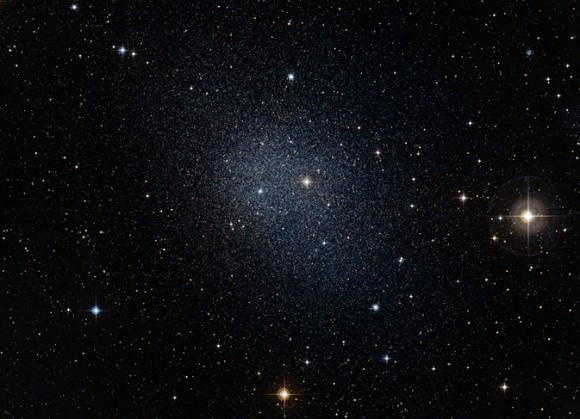Astronomers using NASA’s Fermi Gamma-Ray Space Telescope have been looking for evidence of suspected types of dark matter particles within faint dwarf galaxies near the Milky Way — relatively “boring” galaxies that have little activity but are known to contain large amounts of dark matter. The results?
These aren’t the particles we’re looking for.
80% of the material in the physical Universe is thought to be made of dark matter — matter that has mass and gravity but does not emit electromagnetic energy (and is thus invisible). Its gravitational effects can be seen, particularly in clouds surrounding galaxies where it is suspected to reside in large amounts. Dark matter can affect the motions of stars, galaxies and even entire clusters of galaxies… but when it all comes down to it, scientists still don’t really know exactly what dark matter is.
Possible candidates for dark matter are subatomic particles called WIMPs (Weakly Interacting Massive Particles). WIMPs don’t absorb or emit light and don’t interact with other particles, but whenever they interact with each other they annihilate and emit gamma rays.
If dark matter is composed of WIMPs, and the dwarf galaxies orbiting the Milky Way do contain large amounts of dark matter, then any gamma rays the WIMPs might emit could be detected by NASA’s Fermi Gamma-Ray Space Telescope.
After all, that’s what Fermi does.
Ten such galaxies — called dwarf spheroids — were observed by Fermi’s Large-Area Telescope (LAT) over a two-year period. The international team saw no gamma rays within the range expected from annihilating WIMPs were discovered, thus narrowing down the possibilities of what dark matter is.
“In effect, the Fermi LAT analysis compresses the theoretical box where these particles can hide,” said Jennifer Siegal-Gaskins, a physicist at the California Institute of Technology in Pasadena and a member of the Fermi LAT Collaboration.

This dwarf spheroidal galaxy is a satellite of our Milky Way and is one of 10 used in Fermi's dark matter search. (Credit: ESO/Digital Sky Survey 2)
So rather than a “failed experiment”, such non-detection means that for the first time researchers can be scientifically sure that WIMP candidates within a specific range of masses and interaction rates cannot be dark matter.
(Sometimes science is about knowing what not to look for.)
A paper detailing the team’s results appeared in the Dec. 9, 2011, issue of Physical Review Letters. Read more on the Fermi mission page here.
Source: Universe Today
No hay comentarios:
Publicar un comentario